Solar eclipse of May 20, 2012
| Solar eclipse of May 20, 2012 | |
|---|---|
 Composite image taken from Red Bluff, California | |
| Type of eclipse | |
| Nature | Annular |
| Gamma | 0.4828 |
| Magnitude | 0.9439 |
| Maximum eclipse | |
| Duration | 346 s (5 min 46 s) |
| Coordinates | 49°06′N 176°18′E / 49.1°N 176.3°E |
| Max. width of band | 237 km (147 mi) |
| Times (UTC) | |
| (P1) Partial begin | 20:56:07 |
| (U1) Total begin | 22:06:17 |
| Greatest eclipse | 23:53:54 |
| (U4) Total end | 1:39:11 |
| (P4) Partial end | 2:49:21 |
| References | |
| Saros | 128 (58 of 73) |
| Catalog # (SE5000) | 9535 |
The solar eclipse of May 20, 2012 (May 21, 2012 local time in the Eastern Hemisphere) was an annular solar eclipse that was visible in a band spanning through Eastern Asia, the Pacific Ocean, and North America. As a partial solar eclipse, it was visible from northern Greenland to Hawaii, and from eastern Indonesia at sunrise to northwestern Mexico at sunset.
The annular eclipse was the first visible from the contiguous United States since the solar eclipse of May 10, 1994, and the first in Asia since the solar eclipse of January 15, 2010.[1] The path of the eclipse's antumbra included heavily populated regions of China and Japan, and an estimated 100 million people in those areas were capable of viewing annularity. In the western United States, its path included 8 states, and an estimated 6 million people were capable of viewing annularity.
Visibility and viewing
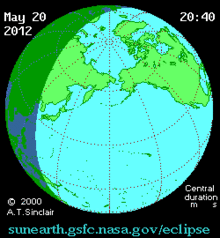
The antumbra had a magnitude of .94 stretched 236 kilometres (147 mi) wide, and traveled eastbound at an average rate of 1.00 kilometre (0.62 mi) per second, remaining north of the equator throughout the event. The longest duration of annularity was 5 minutes and 43 seconds, occurring just south of the Aleutian Islands.[2] The eclipse began on a Monday and ended on the previous Sunday, as it crossed the International Date Line.[1]
Asia
The annular eclipse commenced over the Chinese province of Hainan at sunrise, at 6:06 a.m. China Standard Time. Travelling northeast, antumbra of the eclipse approached and passed over the cities of Guangzhou, Hong Kong, and Xiamen, reaching Taipei, Taiwan by 6:10 a.m. After crossing the East China Sea, it passed over much of eastern Japan, including Nagoya and Tokyo at 7:28 a.m and 7:32 a.m respectively, before entering the Pacific Ocean. The penumbra of the eclipse was visible throughout Eastern Asia and various islands in the Pacific Ocean until noon.[3][2][4][5]
The path of the antumbra over highly populated areas allowed at least an estimated 100 million people to view annularity.[6] Because the eclipse took place during the summer monsoon season in Southeast Asia, viewing conditions were not ideal in some areas, including Hong Kong.[7]
North America
After traveling approximately 4,000 miles (6,437 kilometers) across the Pacific Ocean, the antumbra entered North America between the coastlines of Oregon and California, reaching the coastal city of Eureka, California at 6:28 p.m. PST. After passing over Medford, Oregon and Redding, California, it had reached Reno, Nevada by 6:31 p.m PST. The eclipse continued to travel southeast, passing 30 miles (48 km) north of Las Vegas, Nevada, over St. George, Utah, and reaching the Grand Canyon by approximately 6:35 p.m. After passing over Albuquerque, New Mexico and Lubbock, Texas, the eclipse terminated above central Texas at sunset, 8:39 p.m. CST.[2][4][8] An estimated 6.6 million people lived under the path of the antumbra.[9] The penumbra was visible throughout most of North America, including the islands of Hawaii.[2]
Gallery
Asia
-
Composite image from Keelung, Taiwan
-
Aichi Prefecture, Japan
-
Kōfu, Japan
-
23 wards, Tokyo, Japan
-
Video from Tokyo, Japan
United States
-
Map of the antumbra's path in the United States
-
Animation as viewed from Albuquerque, showing the sunset before the eclipse ended.
-
Amateur scientists observing the eclipse in Albuquerque, New Mexico.
-
Crescent shadows on an outdoor wall in San Francisco, California.
-
Composite image from Huntington Beach, California
-
South shore of Pyramid Lake, Nevada.
-
East of Ogden, Iowa
-
Projection on paper from Medford, Oregon.
Related eclipses
Solar eclipses 2011–2014
This eclipse is a member of a semester series. An eclipse in a semester series of solar eclipses repeats approximately every 177 days and 4 hours (a semester) at alternating nodes of the Moon's orbit.[10]
The partial solar eclipses on January 4, 2011 and July 1, 2011 occur in the previous lunar year eclipse set.
| Solar eclipse series sets from 2011 to 2014 | ||||||
|---|---|---|---|---|---|---|
| Descending node | Ascending node | |||||
| Saros | Map | Gamma | Saros | Map | Gamma | |
118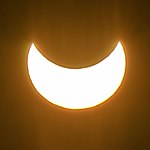 Partial in Tromsø, Norway |
June 1, 2011 Partial |
1.21300 | 123 Hinode XRT footage |
November 25, 2011 Partial |
−1.05359 | |
128 Annularity in Red Bluff, CA, USA |
May 20, 2012 Annular |
0.48279 | 133 Totality in Mount Carbine, Queensland, Australia |
November 13, 2012 Total |
−0.37189 | |
138 Annularity in Churchills Head, Australia |
May 10, 2013 Annular |
−0.26937 | 143 Partial in Libreville, Gabon |
November 3, 2013 Hybrid |
0.32715 | |
148 Partial in Adelaide, Australia |
April 29, 2014 Annular (non-central) |
−0.99996 | 153 Partial in Minneapolis, MN, USA |
October 23, 2014 Partial |
1.09078 | |
Saros 128
This eclipse is a part of Saros series 128, repeating every 18 years, 11 days, and containing 73 events. The series started with a partial solar eclipse on August 29, 984 AD. It contains total eclipses from May 16, 1417 through June 18, 1471; hybrid eclipses from June 28, 1489 through July 31, 1543; and annular eclipses from August 11, 1561 through July 25, 2120. The series ends at member 73 as a partial eclipse on November 1, 2282. Its eclipses are tabulated in three columns; every third eclipse in the same column is one exeligmos apart, so they all cast shadows over approximately the same parts of the Earth.
The longest duration of totality was produced by member 27 at 1 minutes, 45 seconds on June 7, 1453, and the longest duration of annularity was produced by member 48 at 8 minutes, 35 seconds on February 1, 1832. All eclipses in this series occur at the Moon’s descending node of orbit.[11]
| Series members 47–68 occur between 1801 and 2200: | ||
|---|---|---|
| 47 | 48 | 49 |
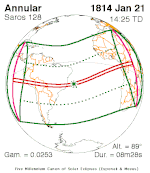 January 21, 1814 |
 February 1, 1832 |
 February 12, 1850 |
| 50 | 51 | 52 |
 February 23, 1868 |
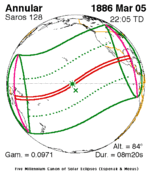 March 5, 1886 |
 March 17, 1904 |
| 53 | 54 | 55 |
 March 28, 1922 |
 April 7, 1940 |
 April 19, 1958 |
| 56 | 57 | 58 |
 April 29, 1976 |
 May 10, 1994 |
 May 20, 2012 |
| 59 | 60 | 61 |
 June 1, 2030 |
 June 11, 2048 |
 June 22, 2066 |
| 62 | 63 | 64 |
 July 3, 2084 |
 July 15, 2102 |
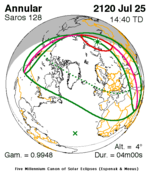 July 25, 2120 |
| 65 | 66 | 67 |
 August 5, 2138 |
 August 16, 2156 |
 August 27, 2174 |
| 68 | ||
 September 6, 2192 | ||
Octon series
The metonic series repeats eclipses every 19 years (6939.69 days), lasting about 5 cycles. Eclipses occur in nearly the same calendar date. In addition, the octon subseries repeats 1/5 of that or every 3.8 years (1387.94 days). All eclipses in this table occur at the Moon's descending node.
| 21 eclipse events between May 21, 1993 and May 20, 2069 | ||||
|---|---|---|---|---|
| May 20–21 | March 9 | December 25–26 | October 13–14 | August 1–2 |
| 118 | 120 | 122 | 124 | 126 |
 May 21, 1993 |
 March 9, 1997 |
 December 25, 2000 |
 October 14, 2004 |
 August 1, 2008 |
| 128 | 130 | 132 | 134 | 136 |
 May 20, 2012 |
 March 9, 2016 |
 December 26, 2019 |
 October 14, 2023 |
 August 2, 2027 |
| 138 | 140 | 142 | 144 | 146 |
 May 21, 2031 |
 March 9, 2035 |
 December 26, 2038 |
 October 14, 2042 |
 August 2, 2046 |
| 148 | 150 | 152 | 154 | 156 |
 May 20, 2050 |
 March 9, 2054 |
 December 26, 2057 |
 October 13, 2061 |
 August 2, 2065 |
| 158 | ||||
 May 20, 2069 | ||||
Notes
References
- ^ a b Friedlander, Blaine (May 17, 2012). "Annular solar eclipse first in 18 years in continental United States on May 20". The Washington Post. Archived from the original on July 19, 2012. Retrieved February 24, 2018.
{{cite news}}: Unknown parameter|deadurl=ignored (|url-status=suggested) (help) - ^ a b c d "Annular Solar Eclipse of 2012 May 20". NASA Goddard Space Flight Center Eclipse Website. NASA. May 13, 2012. Retrieved September 18, 2017.
- ^ "Eclipse Map - May 20-21 Solar Eclipse". TimeandDate.com. Retrieved 13 October 2018.
- ^ a b "Map of Annular Solar Eclipse of May 20, 2012" (Map). Annular Solar Eclipse of May 20, 2012. NASA. 2000. Retrieved October 17, 2017.
- ^ Matsutani, Minoru (May 4, 2012). "Tokyo to be treated to rare annular eclipse, Venus transit". The Japan Times. Retrieved 17 October 2017.
- ^ Beatty, Kelly (March 1, 2012). "May 20th's Annular Eclipse of the Sun". Sky and Telescope. Retrieved September 19, 2017.
- ^ "May the Sun Shine on Rare Eclipse". South China Morning Post. May 20, 2012. Retrieved 13 October 2017.
- ^ Potter, Ned (May 18, 2012). "Solar Eclipse Visible From California to Texas Sunday Afternoon". ABC News. Retrieved September 21, 2017.
- ^ Tariq, Malik (May 21, 2012). "Spectacular "Ring of Fire" Solar Eclipse Wows Millions". Space.com. Retrieved September 19, 2017.
- ^ van Gent, R.H. "Solar- and Lunar-Eclipse Predictions from Antiquity to the Present". A Catalogue of Eclipse Cycles. Utrecht University. Retrieved 6 October 2018.
- ^ "NASA - Catalog of Solar Eclipses of Saros 128". eclipse.gsfc.nasa.gov.






















